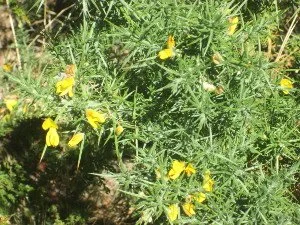Ulex europeaeus
FABACEAE
Gorse, Furz, Common Gorse, Irish Furz
Native to Europe & Nth United Kingdom. Introduced into Australia 150 years ago. A dense, prickly shrub up to 7m but typically 3m tall. Mature plants have spines along the stem. Waxy leaves are very spiny. Green & darkening with age. Young seedlings have trifoliate leaves resembling a small cloverleaf. Yellow pea shaped flowers in clusters towards the ends of branches, usually flowering in Spring & Autumn. Plants start to flower when plant is 18 months old.
Fruit is a dark pod 1 to 2 cm long covered in fine hairs, containing 2 to 6 yellow green seeds. Seeds are released in Summer. Viable for up to 30 years.
Seed spread by seed ejected by ripe seed pods, also by machinery, birds, water & stock.
Gorse occurs in pastures & crops & native vegetation. Resulting in decreased production & biodiversity & an increase in habitat for foxes & rabbits. Extremely flammable & fire regenerative. Prevention is the most cost effective means of control. Prevent flowering & thereby reducing seed.
Integrated control methods must be long running & persistent & with cooperative efforts with neighboring land owners. Herbicide application, on advice of herbicide retailer, when plants are at least 500mm high, best when plants are actively growing during Spring To Summer & after Autumn rain. Do not spray when plants are flowering. Recheck plants after 12 months & reapply herbicide if necessary. Grazing with sheep & especially goats on re emergent seedlings is moderately effective & nutritious to stock. This also applies after controlled burning. But beware, Gorse is extremely flammable.
Biological pest control is very effect when used on this plant. The gorse Spidermite (Tetranychus lintearis) & the Gorse Seed Weevil (Exapion ulicis) reduce the spread of this weed.
Gorse is used in some counties as a hedge plant or stock fodder. The wood has been used to make utensils, due to its on toxic properties, The flowers are also used in Homeopathic Bach Flower Remedies.

